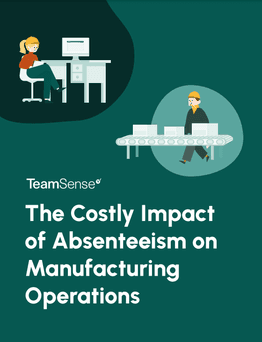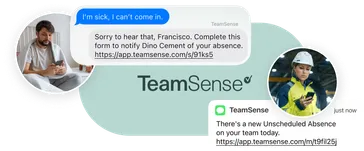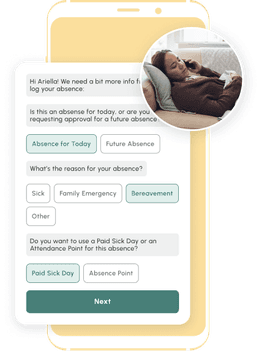When to HR with AI (and When Not To)!
Table of Contents
- Understanding the Impact of 'No Call No Show' on Team Morale
- Impact of No Call No Shows on Team Morale and Productivity
- Strategies to Reduce 'No Call No Show' Incidents and Boost Morale
- Leveraging Text for Better Attendance Management
- Final Thoughts On The Link Between No Call No Shows and Company Morale
How many times has this happened to you? It’s a busy morning, you’ve got your coffee, and you're ready to tackle a hectic day on the floor—only to find out a key player on your team hasn’t shown up for their shift. No heads-up, nothing. Now, you and your team have to scramble to figure out what is going to take a backseat for the day and who is going to pick up what.
Sounds all too familiar, doesn’t it? In sectors like retail and warehousing, a 'no call no show' is more than just an inconvenience; it’s a critical hiccup that can throw off the whole day’s operations. The unexpected extra work (without the extra pay) can really take a toll on the team’s morale, especially if no-call no-shows are a continuous problem. In this post, we're diving into the ripple effects of excessive absenteeism, specifically, employee no call no shows, breaking down why they happen, and most importantly, sharing some solid strategies to help prevent them and keep your team's spirit up and maybe even reduce employee turnover!
Understanding the Impact of 'No Call No Show' on Team Morale
When someone doesn’t show up for their shift without any notice, it’s like knocking over the first domino in a long chain. This isn’t just about filling a gap; it’s about the wave of extra stress and confusion that spreads through your team. Here’s how these incidents can shake the foundations of team morale and what that means in the daily grind.
Definition and Frequency
First things first, let's define it. A 'no call no show' happens when an employee misses their shift without notifying their manager or team. You might think it’s a rare occurrence, but in reality, it's surprisingly common, especially in high-pressure environments like retail and warehousing. Tracking these incidents is crucial because understanding the pattern can help us address the root causes.
Try as I might, pinning down an average 'no call no show' rate for employees was like trying to catch smoke with your bare hands. But here’s the scoop— no shows really shake things up for businesses, especially those that rely on everyone showing up for their shifts. Depending on where you are and what your business does, these rates can swing from a low-key 2% to a hectic 15%. That's no small thing!
This unpredictability can throw a wrench in the works, causing not just a few headaches but real dips in how things run day-to-day. That’s why you’ll see a lot of companies getting savvy with reminders via text, and tightening up their attendance policies to keep these no-show surprises to a minimum.
Common Reasons for 'No Call No Show'
So, why do employees pull a disappearing act? The reasons can vary from the understandable to the avoidable—from personal emergencies and health issues to a deeper sense of job dissatisfaction or poor communication channels within the company.
Valid No Call No Show Excuses
These are the kinds of unforeseen situations where an employee genuinely can’t notify the employer in advance:
- Medical Emergencies: Sudden illnesses or accidents that need immediate attention.
- Family Emergencies: Urgent family situations, like a severe illness or accident involving a loved one.
- Transportation Issues: Unexpected problems like car breakdowns or public transport disruptions.
- Natural Disasters: Severe weather conditions or other natural events that make travel unsafe.
- Communication Failures: Situations where the employee tries to reach out but can't due to technical issues.
Unacceptable No Call No Show Excuses
These excuses could have been anticipated or communicated ahead of time:
- Non-urgent Personal Matters: Skipping work for a concert or a non-critical appointment.
- Avoidable Transportation Issues: Not refueling the car or missing the bus due to poor time management.
- Minor Illnesses or Discomforts: When the condition isn’t severe enough to impede communication.
- Recreational Activities: Planning a day out or a trip without prior notification or leave application.
- Repeated Patterns: Regularly using the same excuse, showing a pattern of irresponsible behavior.
Sometimes, it’s about feeling underappreciated or disconnected from the team. Company morale and, team morale, more importantly, are often taken for granted with the day-to-day stress of normal ops. Recognizing these triggers is the first step in preventing future occurrences.

The Costly Impact of Absenteeism on Manufacturing Operations
Learn how chronic, unplanned absenteeism is a costly impediment to manufacturing productivity and efficiency, and how you can reduce absenteeism.
Impact of No Call No Shows on Team Morale and Productivity
No call no shows are like that one puzzle piece you can't find—you know, the piece that keeps the whole picture from coming together. But don't just take our word for it. Studies reveal that low morale not only impacts individual teams but can also take a heavy toll on the broader economy. A report by the Gallup Organization1 underscores this, showing that 22 million disengaged employees contribute to an estimated $350 billion in lost productivity annually in the U.S. alone. This staggering figure highlights the importance of addressing no call no show issues, which can significantly disrupt workplace dynamics and productivity.
Disruption of Workflow
A typical workday can quickly be thrown into chaos because the team is a person short without notice. Projects stall, customers wait longer, and the remaining team members scramble to cover the gaps. This isn't just frustrating; it's costly. When doing our research and looking at statistics surrounding absenteeism, we found that the average productivity loss associated with an unplanned absence is a staggering 36.6%, compared to 22.6% for planned absences. This level of disruption can cripple a team's ability to meet its objectives and maintain smooth operations.
Effect on Team Dynamics & Company Culture
It's more than just extra work; it's a trust issue. When team members regularly disappear, it seeds doubt and frustration among the crew. This uncertainty can sour the workplace atmosphere and erode the sense of camaraderie, crucial for a positive work environment. Plus, engaged teams aren't just happier; they're more profitable, with a 22% jump in profits and a 37% drop in absenteeism2 when morale is high.
Lowering Overall Morale
And let’s talk morale—when teams constantly have to pick up the slack for missing colleagues, it doesn’t just drain their energy; it can leave them feeling undervalued and overworked. This non-stop cycle can deflate the most dedicated employees, turning even the reliable ones into potential no-shows themselves. That's why crafting a work environment where everyone feels valued isn't just nice; it's essential. It's the secret sauce that leads to fewer absences and skyrockets performance, keeping your workplace not only functioning but thriving.
By tackling the tricky issue of no call no shows head-on, businesses can foster a more vibrant, engaged, and cohesive workplace.

Strategies to Reduce 'No Call No Show' Incidents and Boost Morale
Let’s get real—no call no shows are more than a minor annoyance; they’re a big deal for every single person working on the shift. When a team member goes MIA without a heads-up, it disrupts everything from your workflow to team dynamics. So, what can you do to minimize these disruptions and keep the team spirit alive? Here are some grounded strategies that really work.
Enhancing Communication Practices
It all starts with communication. Clear, direct, and easy—that’s how your communication channels should be. We admit that it is more challenging to communicate with hourly employees who often don't have access to company email. But there are other ways to get a message sent out. By implementing a straightforward method like texting, you allow for quick and reliable exchanges (plus, 95% of texts are read within the first 3 minutes!3). Introducing an absence reporting system like TeamSense can revolutionize this process. It enables employees to quickly notify managers of any changes via text, ensuring that everyone is on the same page without delay. This kind of simplicity in communication can significantly reduce the chances of no call no shows.

Implementing Flexible Scheduling
Life’s unpredictable, and a rigid schedule doesn’t always cut it. By integrating flexible scheduling options, you allow your team to have a say in when they work. This can be a game changer in reducing stress and absenteeism. Whether it’s allowing shift swaps with approval or offering various shift times, flexibility can lead to fewer unplanned absences and a happier, more engaged team.
Strengthening Attendance Policies
A clear and consistent attendance policy with a defined no call no show policy sets the tone. Everyone should know what’s expected of them and the consequences of not following through. Ensure these policies are communicated effectively right from the start—during onboarding and regular team meetings. Such clarity helps prevent misunderstandings and fosters a culture of accountability.
Implementing Recognition and Rewards Programs
Let's change up the way we say "thank you" to our team! The old saying "actions speak louder than words" holds true, even in a professional working environment. Recognizing and rewarding reliable attendance isn't just about giving a pat on the back—it's about making your team feel seen and appreciated. Why not roll out a 'Perfect Attendance Awards' program? Every month or quarter, those who haven't missed a shift get entered into a raffle for something cool, like extra vacation days or a dinner out with the company. Or, set up a points system where showing up not only counts on the floor but adds up to score gift cards or a prime parking spot for a month. It’s a fun and engaging way to encourage punctuality and boost morale.
Supporting Employee Well-Being
When it comes to keeping our team happy and healthy, a little support goes a long way. Stress busters? Yes, please! How about subsidizing memberships to a meditation app or setting up a cozy corner for some midday decompression? Some companies are even going as far as adding a "scream room" (even Google added one for their employees). And let’s not forget about professional mental health support through robust employee assistance programs (EAPs). Creating a workplace where folks feel they can openly talk about and manage their stress is key to keeping everyone ready to roll each day.
Providing Professional Development Opportunities
Ever thought about how a little learning could make a big difference in keeping your team keen and on the scene? Offering development opportunities such as workshops, seminars, or even a stipend for further education shows your team that you’re invested in their future. It’s about growing with them. When they see that you’re doubling down on their growth, they’ll likely double down on their commitment—meaning fewer empty shifts and a happier, more engaged crew.
Each of these strategies is about creating an environment where employees are not just showing up, but are happy, engaged, and growing. It's about building a workplace that feels as good as it functions, cutting down on those pesky no call no shows and keeping the team vibe vibrant.
Leveraging Text for Better Attendance Management

Managing attendance effectively is crucial, and technology can make a world of difference. No one wants to talk to their boss or a 1-800 stranger to call off. That's where solutions like TeamSense come into play. With TeamSense, employees can simply text in their absence. It’s quick, easy, and removes the awkwardness of making that dreaded call.
Plus it virtually eliminates misunderstandings around attendance. For example, an employee calls in to leave a voicemail about missing a shift. The person who listens to it forgets to log it, the voicemail gets deleted, and suddenly, it's a game of "he said, she said".
Error in manual processes can lead to unnecessary conflicts and incorrect attendance records. By leveraging text-based solutions, this issue is virtually eliminated. Text messages are immediate and leave a digital trail, reducing the chances of miscommunication and forgotten messages, everything is automatically logged in a database immediately.
With TeamSense, employees call off by sending a quick text to report their absence, ensuring the information is captured accurately and promptly. This streamlined process not only helps in reducing no call no shows but also boosts transparency and reliability in attendance management. By automating this critical part of operations, you can focus on what matters most: running a smooth and efficient business.

No one wants to talk to their boss or a 1-800 stranger to call off. Text changes everything - Reducing No Call No Shows.
Final Thoughts On The Link Between No Call No Shows and Company Morale
No call no shows are more than just a scheduling headache—they’re a major disruptor to team morale and productivity. When someone bails without notice, it throws a wrench into the entire operation, leading to stress, frustration, and a hit to team spirit.
We’ve covered how these incidents can mess up workflow, causing delays and extra work for everyone left behind. The ripple effect is real, with unplanned absences leading to a staggering 36.6% drop in productivity. And it's not just about the work; it’s about trust. Repeated no call no shows can erode trust within the team, turning a cohesive group into a cluster of uncertainty and frustration.
But we’re not just here to talk about problems—we’re here to solve them. We’ve outlined some solid strategies to tackle these issues head-on:
- Enhancing Communication Practices: Implement simple, direct communication methods like texting with TeamSense to streamline the process and reduce miscommunication.
- Implementing Flexible Scheduling: Allow for shift swaps and flexible hours to help employees manage their personal lives without needing to miss work.
- Strengthening Attendance Policies: Clear, consistent policies set expectations and ensure everyone knows the rules.
- Promoting Employee Engagement: Create a work environment that values and engages employees, making them less likely to miss work without notice.
- Providing Supportive Resources: Offer support for personal challenges, from childcare solutions to mental health resources, to help employees balance work and life.
In the end, addressing no call no shows isn’t just about filling gaps; it’s about building a stronger, more resilient team. By focusing on communication, flexibility, engagement, and support, you can boost morale and keep your operations running smoothly. Thanks for sticking with us, and here’s to keeping your team’s spirit high and their attendance reliable!
About the Author

Jackie Jones, Employee Engagement & Attendance Specialist
Jackie Jones has over three years of experience helping HR teams improve employee morale, reduce absenteeism, and create happier, more engaged workplaces. With a strong background in employee relations and attendance management, she brings practical strategies and insights that support frontline teams and the HR professionals who lead them.


